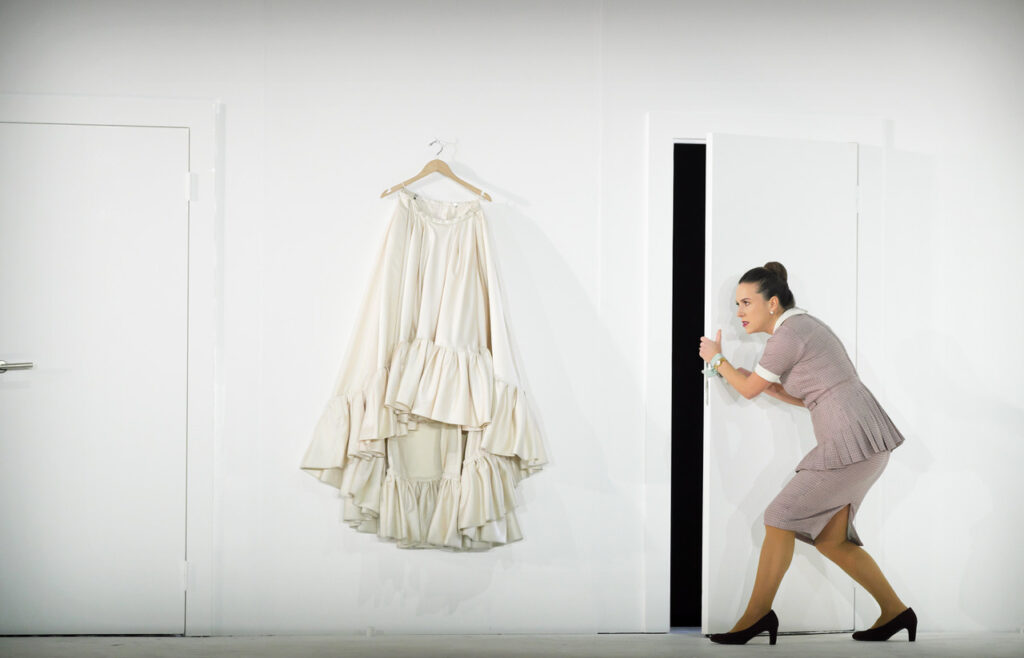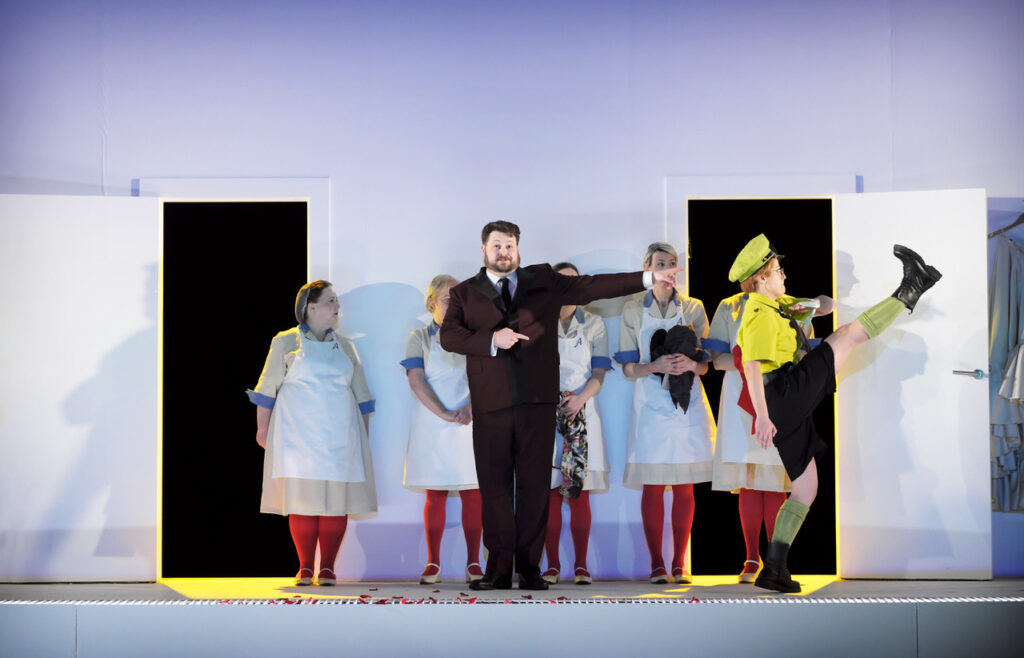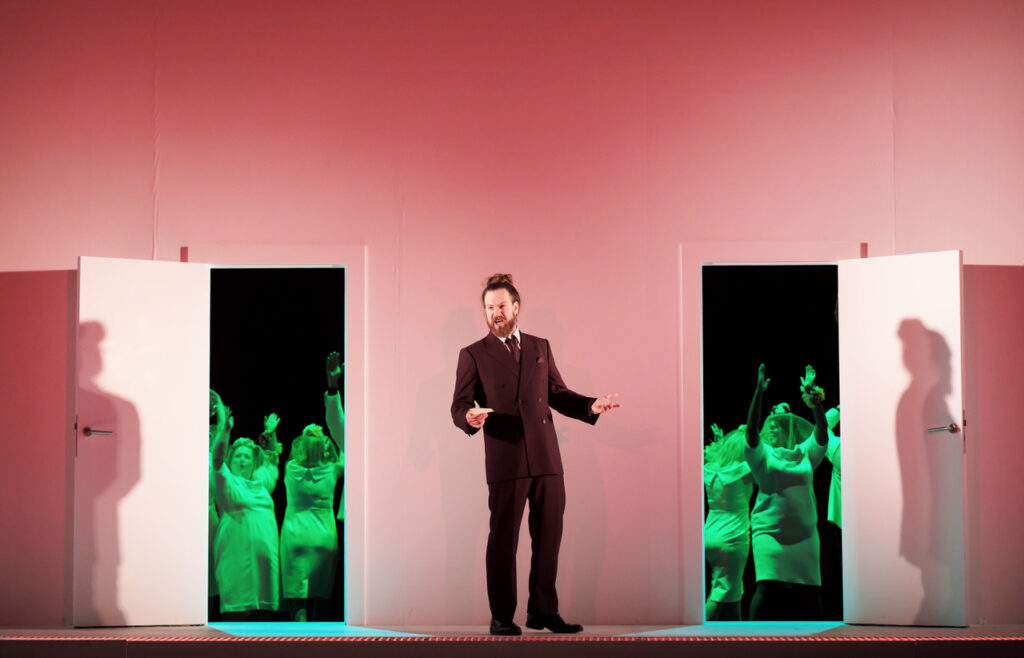I’ve always found it strange that in the English language the title of one of the most popular pieces in the repertory is rendered as The Marriage of Figaro. The Italian nozze refers to the ceremony itself, whereas matrimonio to the state of wedded bliss that follows afterwards (or not, as the case may be). Such a distinction also applies in German (Hochzeit, Ehe) and in French (les noces, mariage). This matters because both the story itself and the opera which Mozart composed revolve around events leading up to the act of holy matrimony, with nothing else beyond that, and all of this occurs during the course of a single day. But then, this is an opera in which all is not as it seems: the noble Countess and humble Susanna exchange roles, a key familial relationship is not revealed to the unsuspecting players until late in the game, and a pageboy is actually a trouser role.

In a programme note, the director of English National Opera’s latest production, Joe Hill-Gibbins, is concerned to shift the focus away from the overturning of old social orders and hierarchies towards the interplay through character relationships of power and sex. In a modern-day setting feudalism is difficult to realise and the English translation sometimes struggles linguistically with status: Count Almaviva is variously referred to as “Monsieur” and “my Lord”, though the only physical characteristic indicating his superiority is a top knot. The translation is not always successful. Thus recitatives frequently degenerate into a kind of W.S. Gilbert patter with all too obvious rhymes, a peppering of blunt colloquialisms (“buggering off”; “washing your mouth out”; Cherubino riding back “from Seville like the clappers”). However, there are some memorable phrases: Figaro describes Marcellina as “you gaudy old parakeet” (though she is not dressed like that) and in Act 3 Susanna declares to the Count that “women of my class don’t suffer from headaches”.
Hill-Gibbins makes much of physicality and sensuality. I find it hard to recall any other production in which there is so much pawing, mauling and groping. Cherubino is very touchy-feely with the Countess, stroking her posterior at one point, and the Count takes Susanna from behind while rubbing her abdominal area. Above all, the Movement Director Jenny Ogilvie gives all the characters much to do, so much so that they seem to be in perpetual motion. There are side shuffles; Cherubino demonstrates his military fitness with press-ups; Susanna slaps, punches and kicks; Figaro conducts the chorus with his own baton; he and the Count repeatedly crawl on all fours; and there are hints at recently attended tai-chi classes. Inevitably, there is a resultant breathlessness, only mitigated by a slowing-down in the final two acts, in which the protagonists, even in their big arias, find little or no inner repose.

Few costumes bear any relation to status, unless it is an underlining of equality. Both Figaro and the Count are suited, Susanna’s wedding dress also serves the Countess when she is in disguise, the household servants (how many minor nobles or plutocrats can afford such a retinue today?) are kitted out as a complete catering corps, and Cherubino’s “uniform” is more suggestive of Boy Scouts than military personnel. Earlier, her Hawaiian-like top is peopled with the heads of her amorous desires. Antonio, meanwhile, is instantly recognisable as the gardener with his outdoor sweater and long rubber gloves.
The staging, with sets designed by Johannes Schütz, is effective in its own way. Most of the action revolves around a box-like construction, occupying half the stage height, shallow of depth, with four doors leading off the back to facilitate entrances and exits. When open they provide space behind which characters can hide. This box is frequently raised and lowered (a little too often, I think), in order to depict the Countess’s bedchamber, for instance, or to conjure up the impression of a garden below. The box itself creates a powerful sense of claustrophobia, relieved only in the final act by pulling it right back, exposing a wide open stage with ample opportunity for running about. Matthew Richardson’s lighting leaves the box clinically white for most of the time, shifting through hues of mid-grey, powder-blue, apple-green and rosy-lilac.
Nardus Williams sings an impressive Countess. She is regal in bearing without ever appearing haughty. Her evenness of line, clarity of articulation and creamy richness of tone are a constant delight. In her Act 2 cavatina (“Porgi, amor, qualche ristoro”) she reveals the depth of her sorrow without a hint of mawkishness, while in her most famous aria (“Dove sono”), in which she tenderly recounts the strength of her feelings for Almaviva, her voice soars majestically like a lark at the close. Mary Beavan is a very personable Susanna, her fresh-toned soprano running effortlessly through the gamut of emotions which her character is required to display, such as her comment to Figaro about the Count’s persistence, “Proximity makes the heart grow fonder”. I missed a degree of vocal richness in Hanna Hipp’s Cherubino, though she luxuriates in all her gamine opportunities. Rebecca Evans is a very solid Marcellina and Ava Dodd brings a youthful infectiousness to the role of Barbarina as well as poignancy for her minor-key aria at the start of Act 4.

I wasn’t quite persuaded by Cody Quattelbaum’s Count. Is he something of a domestic tyrant or does he suffer from a mere surfeit of male hormones? His voice is certainly powerful and his deep baritone rings out clearly, too much so at times when it takes on a hectoring quality, with a tendency to project too forcefully in ensembles. He is unquestionably irascible, choleric even, but somehow plain humanity is in short supply. There is no diffidence in the way David Ireland sings his Figaro. Even when he’s fooling about on stage, there’s no mistaking the fact that he sees himself as the central character. There is plenty of authority in the voice for his first big aria (“Se vuol ballare”) where he makes abundantly clear that he is the one who calls the tune, finely underpinned by horns in the accompaniment. His ringing top notes are unfailingly secure. Neal Davies is a wonderfully deep-toned and rich Dr Bartolo.
At the very beginning I found Ainārs Rubiķis’s pacing of the score too impatient, the over-driven overture especially so, but he soon revealed his considerable strengths: his flexibility in the tempos, always supportive of his singers, not least in the ensemble pieces, an admirable attention to instrumental detail with due weighting of the bass line, and the end of Act 2 delivered in thrillingly spirited fashion. Only the very reticent harpsichord bothered me.
Sex and sensuality in this new ENO production are indubitably writ large, there are plenty of bubbles of amusement to delight eye and ear, vocally and orchestrally the performance can hold its own in any comparison, but I do feel Hill-Gibbins underplays one of his two declared points of focus. Amorous relationships there are aplenty, but where are the insignias, the livery and watermarks of power itself?
Alexander Hall
The Marriage of Figaro (Le nozze di Figaro)
Opera in four acts with a libretto by Lorenzo da Ponte based on La Folle Journée ou le Mariage de Figaro by Pierre-Augustin Caron de Beaumarchais
English translation by Jeremy Sams
Music by Wolfgang Amadeus Mozart
Co-production with Oper Wuppertal
Cast and production staff:
Susanna – Mary Beavan; Figaro – David Ireland; Dr Bartolo – Neal Davies; Marcellina – Rebecca Evans; Cherubino – Hanna Hipp; Don Basilio/Don Curzio – Hubert Francis; Countess Almaviva – Nardus Williams; Count Almaviva – Cody Quattelbaum; Antonio – Trevor Eliot Bowes; Barbarina – Ava Dodd
Director – Joe Hill-Gibbins; Set Designer – Johannes Schütz; Costume Designer – Astrid Klein; Lighting Designer – Matthew Richardson; Associate Director and Movement Director – Jenny Ogilvie; Chorus and Orchestra of English National Opera; Conductor – Ainārs Rubiķis
Coliseum, London, 5 February 2025
Further performances until 22 February
Photos © Zoe Martin